Functional Energy Accumulation, Photo- and Magnetosensitive Hybridity in the GaSe-Based Hierarchical Structures
Abstract
1. Introduction
2. Materials and Methods
3. Results and Discussion
- The light illumination of the GaSe(CS(NH2)2(SmCl3)) structure causes tunnel current flow, levelling the contribution caused by charge accumulation in the infra-low-frequency region (Figure 13c).
4. Conclusions
- The complex hierarchical structures of GaSe(CS(NH2)2), GaSe(SmCl3), and GaSe(CS(NH2)2(SmCl3)) were synthesized by intercalation technique. The non-additive influence of both the subhost and the guest components on the real part of the complex impedance for the GaSe(CS(NH2)2(SmCl3)) clathrate is observable in the frequency region characteristic for band carriers. This proves that hierarchical modulating potential has a considerable impact on the electron impurity spectrum, which provides current flow under normal conditions;
- The GaSe(CS(NH2)2(SmCl3)) clathrate is characterised by an unproportionally higher density of deep trap centres compared to the associative influence of the guest CS(NH2)2 and SmCl3 components. The hierarchy of barrier potential, on the other hand, results in a decrease in the hopping radius of charge carriers;
- The increase in the photoresistive effect is provided by the complexity of the hierarchical structure. The magnetoresistive effect in GaSe(CS(NH2)2(SmCl3)), on the other hand, is considerably smaller compared to SmCl3 in the subhost potential field. The Zeeman effect influences the impurity energy spectrum, thus decreasing the density of deep trapping centres in the magnetic field;
- The strong inductive response, observable in the low-frequency region for the hierarchical GaSe(SmCl3) clathrate, makes this material promising for the development of gyrator-free nanodelay lines, with prospects for nanoelectronics applications;
- The hysteresis in the volt-ampere characteristics of the hierarchical GaSe(CS(NH2)2(SmCl3)) clathrate confirms the electric energy accumulation at the interphase boundaries. The EMF observed in the experiment is generated due to the spin battery effect in the stationary magnetic field.
Author Contributions
Funding
Conflicts of Interest
References
- Ramamurthy, V.; Mondal, B. Supramolecular photochemistry concepts highlighted with select examples. J. Photochem. Photobiol. C Photochem. Rev. 2015, 23, 68–102. [Google Scholar] [CrossRef]
- Amabilino, D.B.; Smith, D.K.; Steed, J.W. Supramolecular materials. Chem. Soc. Rev. 2017, 46, 2404–2420. [Google Scholar] [CrossRef] [PubMed]
- Hashim, P.; Bergueiro, J.; Meijer, E.; Aida, T. Supramolecular Polymerization: A Conceptual Expansion for Innovative Materials. Prog. Polym. Sci. 2020, 105, 101250. [Google Scholar] [CrossRef]
- Snyder, G.J.; Christensen, M.; Nishibori, E.; Caillat, T.; Iversen, B.B. Disordered zinc in Zn4Sb3 with phonon-glass and electron-crystal thermoelectric properties. Nat. Mater. 2004, 3, 458–463. [Google Scholar] [CrossRef] [PubMed]
- Ishiwata, S.; Shiomi, Y.; Lee, J.S.; Bahramy, M.S.; Suzuki, T.; Uchida, M.; Arita, R.; Taguchi, Y.; Tokura, Y. Extremely high electron mobility in a phonon-glass semimetal. Nat. Mater. 2013, 12, 512–517. [Google Scholar] [CrossRef]
- Takabatake, T.; Suekuni, K.; Nakayama, T.; Kaneshita, E. Phonon-glass electron-crystal thermoelectric clathrates: Experiments and theory. Rev. Mod. Phys. 2014, 86, 669–716. [Google Scholar] [CrossRef]
- Slack, G. New Materials and Performance Limits for Thermoelectric Cooling. In CRC Handbook of Thermoelectrics; Rowe, D.M., Ed.; CRC Press: Boca Raton, FL, USA, 1995; pp. 407–440. [Google Scholar]
- Slack, G.A. Design Concepts for Improved Thermoelectric Materials. In Proceedings of the MRS, Cambrige, UK, 31 March–3 April 1997; Cambridge University Press: Cambridge, UK, 1997; Volume 478, pp. 47–54. [Google Scholar]
- Shevelkov, A.V.; Kelm, E.A.; Olenev, A.V.; Kulbachinskii, V.A.; Kytin, V.G. Anomalously low thermal conductivity and thermoelectric properties of new cationic clathrates in the Sn-In-As-I system. Semiconductors 2011, 45, 1399–1403. [Google Scholar] [CrossRef]
- Borshch, N.; Pereslavtseva, N.S.; Kurganskii, S.I.; Kurganskiĭ, S.I. Electronic structure of Zn-substituted germanium clathrates. Semiconductors 2009, 43, 563–567. [Google Scholar] [CrossRef]
- Uemura, T.; Akai, K.; Koga, K.; Tanaka, T.; Kurisu, H.; Yamamoto, S.; Kishimoto, K.; Koyanagi, T.; Matsuura, M. Electronic structure and thermoelectric properties of clathrate compounds Ba8AlxGe46−x. J. Appl. Phys. 2008, 104, 013702. [Google Scholar] [CrossRef]
- Blake, N.; Mollnitz, L.; Stucky, G.; Metiu, H. The electronic structure and transport properties of clathrates: A density functional study. In Proceedings of the Eighteenth International Conference on Thermoelectrics. Proceedings, ICT’99 (Cat. No.99TH8407), Institute of Electrical and Electronics Engineers (IEEE), Baltimore, MD, USA, 29 August–2 September 1999; pp. 489–492. [Google Scholar]
- Ibrahim, M.S.; Etaiw, S.E.H. Supramolecular host–guest systems as frameworks for excitation energy transfer. Spectrochim. Acta Part A Mol. Biomol. Spectrosc. 2002, 58, 373–378. [Google Scholar] [CrossRef]
- Guarino, A.; Occhiucci, G.; Possagno, E.; Bassanelli, R. Excitation energy transfer in clathrates. J. Chem. Soc. Faraday Trans. Phys. Chem. Condens. Phases 1976, 72, 1848–1855. [Google Scholar] [CrossRef]
- De Girolamo Del Mauro, A.; Carotenuto, M.; Venditto, V.; Petraccone, V.; Scoponi, M.; Guerra, G. Fluorescence of Syndiotactic Polystyrene/Trimethylbenzene Clathrate and Intercalate Co-Crystals. Chem. Mater. 2007, 19, 6041–6046. [Google Scholar] [CrossRef]
- Bishchaniuk, T.M.; Grygorchak, I. Colossal magnetocapacitance effect at room temperature. Appl. Phys. Lett. 2014, 104, 203104. [Google Scholar] [CrossRef]
- Grygorchak, I.; Ivashchyshyn, F.; Tokarchuk, M.V.; Pokladok, N.T.; Viznovych, O.V. Modification of properties of GaSe<β-cyclodexterin<FeSO4>> Clathrat by synthesis in superposed electric and light-wave fields. J. Appl. Phys. 2017, 121, 185501. [Google Scholar] [CrossRef]
- Wu, Y.; Fuh, H.-R.; Zhang, D.; Coileáin, C.Ó.; Xu, H.; Cho, J.; Choi, M.; Chun, B.S.; Jiang, X.; Abid, M.; et al. Simultaneous large continuous band gap tunability and photoluminescence enhancement in GaSe nanosheets via elastic strain engineering. Nano Energy 2017, 32, 157–164. [Google Scholar] [CrossRef]
- Lies, R.M.A. III–VI Compounds. In Preparation and Cryst Growth Materials with Layered Structure; Springer: Dordrecht, The Netherlands, 1977; pp. 225–254. [Google Scholar]
- Friend, R.H.; Yoffe, A.D. Electronic Properties of intercalation complexes of the transition metal dichalcogenides. Adv. Phys. 1987, 1, 1–94. [Google Scholar] [CrossRef]
- Puzzarini, C. Molecular Structure of Thiourea. J. Phys. Chem. A 2012, 116, 4381–4387. [Google Scholar] [CrossRef]
- Harris, K.D.M.; Aliev, A.E.; Girard, P.; Jones, M.J.; Guillaume, F.; Dianoux, A.-J. Molecular dynamics of cyclohexane guest molecules in the cyclohexane/thiourea inclusion compound: An incoherent quasielastic neutron scattering investigation. Mol. Phys. 1998, 93, 545–554. [Google Scholar] [CrossRef]
- Pluta, T.; Sadlej, A.J. Electric properties of urea and thiourea. J. Chem. Phys. 2001, 114, 136. [Google Scholar] [CrossRef]
- Shumaila; Lakshmi, G.B.; Alam, M.; Siddiqui, A.M.; Husain, M. Samarium Chloride (SmCl3) Doped Poly(o-Toluidine): Synthesis and Characterization. Sci. Adv. Mater. 2013, 5, 64–70. [Google Scholar] [CrossRef]
- Ivashchyshyn, F.; Grygorchak, I.; Stakhira, P.; Cherpak, V.; Micov, M. Nonorganic Semiconductor–Conductive polymer intercalate nanohybrids: Fabrication, properties, application. Curr. Appl. Phys. 2012, 12, 160–165. [Google Scholar] [CrossRef]
- Grygorchak, I.; Ivashchyshyn, F.; Stakhira, P.; Reghu, R.R.; Cherpak, V.; Grazulevicius, J.V. Intercalated Nanostructure Consisting of Inorganic Receptor and Organic Ambipolar Semiconductor. J. Nanoelectron. Optoelectron. 2013, 8, 292–296. [Google Scholar] [CrossRef]
- Stoynov, Z.; Grafow, B.; Savova-Stoynov, B.; Elkin, V. Electrochemical Impedance; Nauka: Moscow, Russia, 1991. (In Russian) [Google Scholar]
- Barsoukov, E.; Macdonald, J.R. Impedance Spectroscopy. In Theory, Experiment and Application; Wiley: Hoboken, NJ, USA, 2005; p. 585. [Google Scholar]
- Ertap, H.; Yuksek, M.; Karatay, A.; Elmali, A.; Karabulut, M. Linear and nonlinear absorption, SHG and photobleaching behaviors of Dy doped GaSe single crystal. Chin. J. Phys. 2019, 59, 465–472. [Google Scholar] [CrossRef]
- Pollak, M.; Geballe, T.H. Low-Frequency Conductivity Due to Hopping Processes in Silicon. Phys. Rev. 1961, 122, 1742–1753. [Google Scholar] [CrossRef]
- Jonscher, A.K. The ‘universal’ dielectric response. Nature 1977, 267, 673–679. [Google Scholar] [CrossRef]
- Bruce, J.; Ingram, M.; MacKenzie, M.; Syed, R. Ionic conductivity in glass: A new look at the weak electrolyte theory. Solid State Ion. 1986, 18, 410–414. [Google Scholar] [CrossRef]
- Luryi, S. Quantum capacitance devices. Appl. Phys. Lett. 1988, 52, 501–503. [Google Scholar] [CrossRef]
- Mora-Seró, I.; Bisquert, J.; Fabregat-Santiago, F.; Garcia-Belmonte, G.; Zoppi, G.; DuRose, K.; Proskuryakov, Y.; Oja, I.; Belaidi, A.; Dittrich, T.; et al. Implications of the Negative Capacitance Observed at Forward Bias in Nanocomposite and Polycrystalline Solar Cells. Nano Lett. 2006, 6, 640–650. [Google Scholar] [CrossRef]
- Bisquert, J.; Randriamahazaka, H.; Garcia-Belmonte, G. Inductive behaviour by charge-transfer and relaxation in solid-state electrochemistry. Electrochim. Acta 2005, 51, 627–640. [Google Scholar] [CrossRef]
- Bishchaniuk, T.M.; Grygorchak, I.; Fechan, A.; Ivashchyshyn, F. Semiconductor clathrates with a periodically modulated topology of a host ferroelectric liquid crystal in thermal, magnetic, and light-wave fields. Tech. Phys. 2014, 59, 1085–1087. [Google Scholar] [CrossRef]
- Hai, P.N.; Ohya, S.; Tanaka, M.; Barnes, S.E.; Maekawa, S. Electromotive force and huge magnetoresistance in magnetic tunnel junctions. Nature 2009, 458, 489–492. [Google Scholar] [CrossRef] [PubMed]
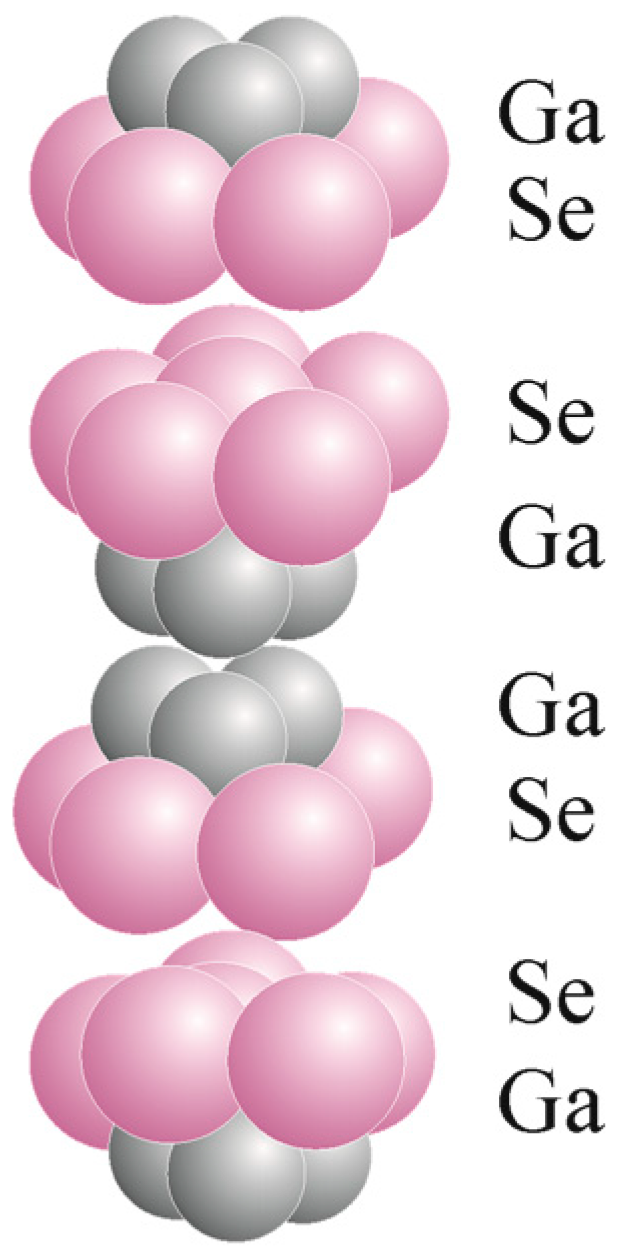
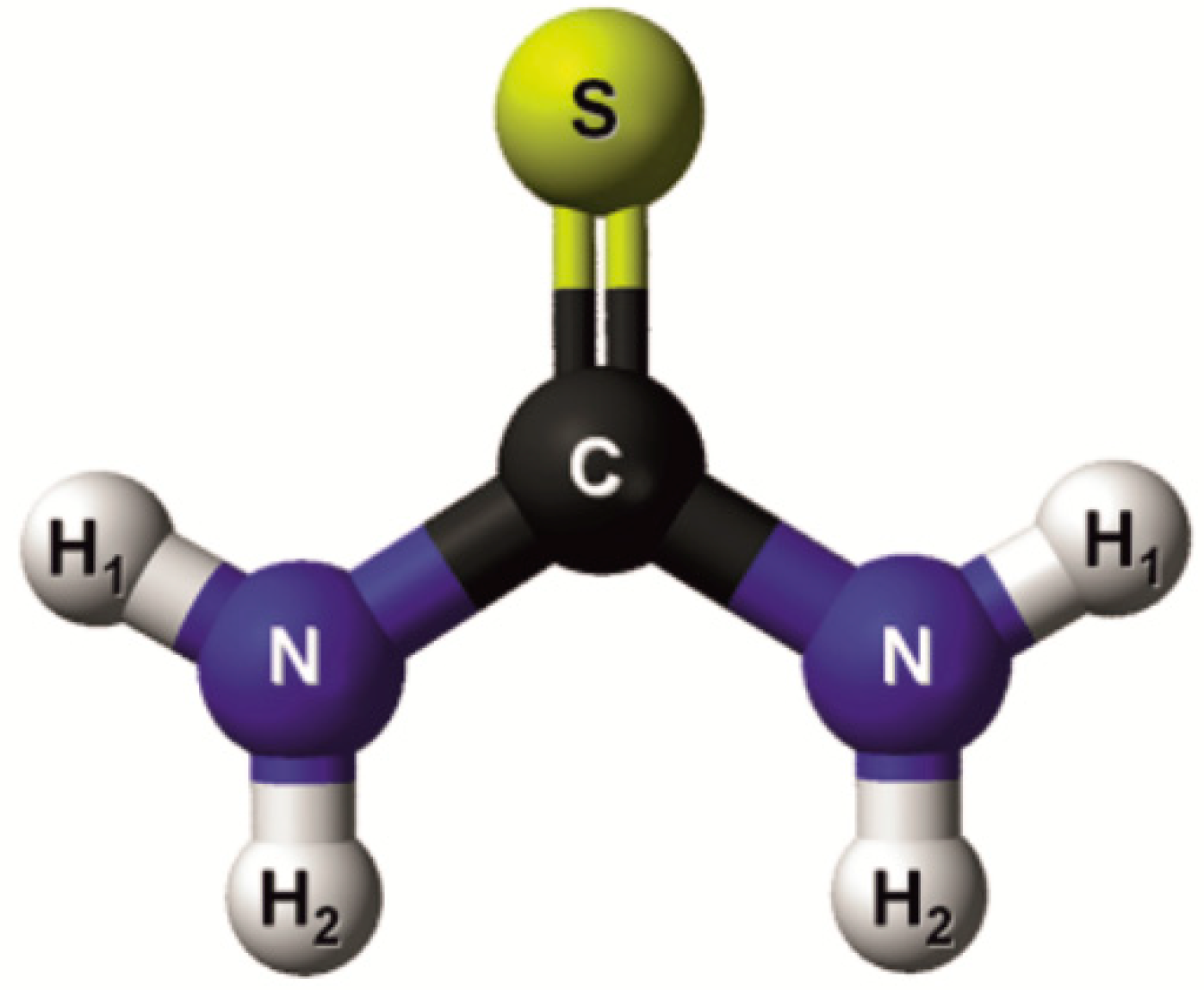
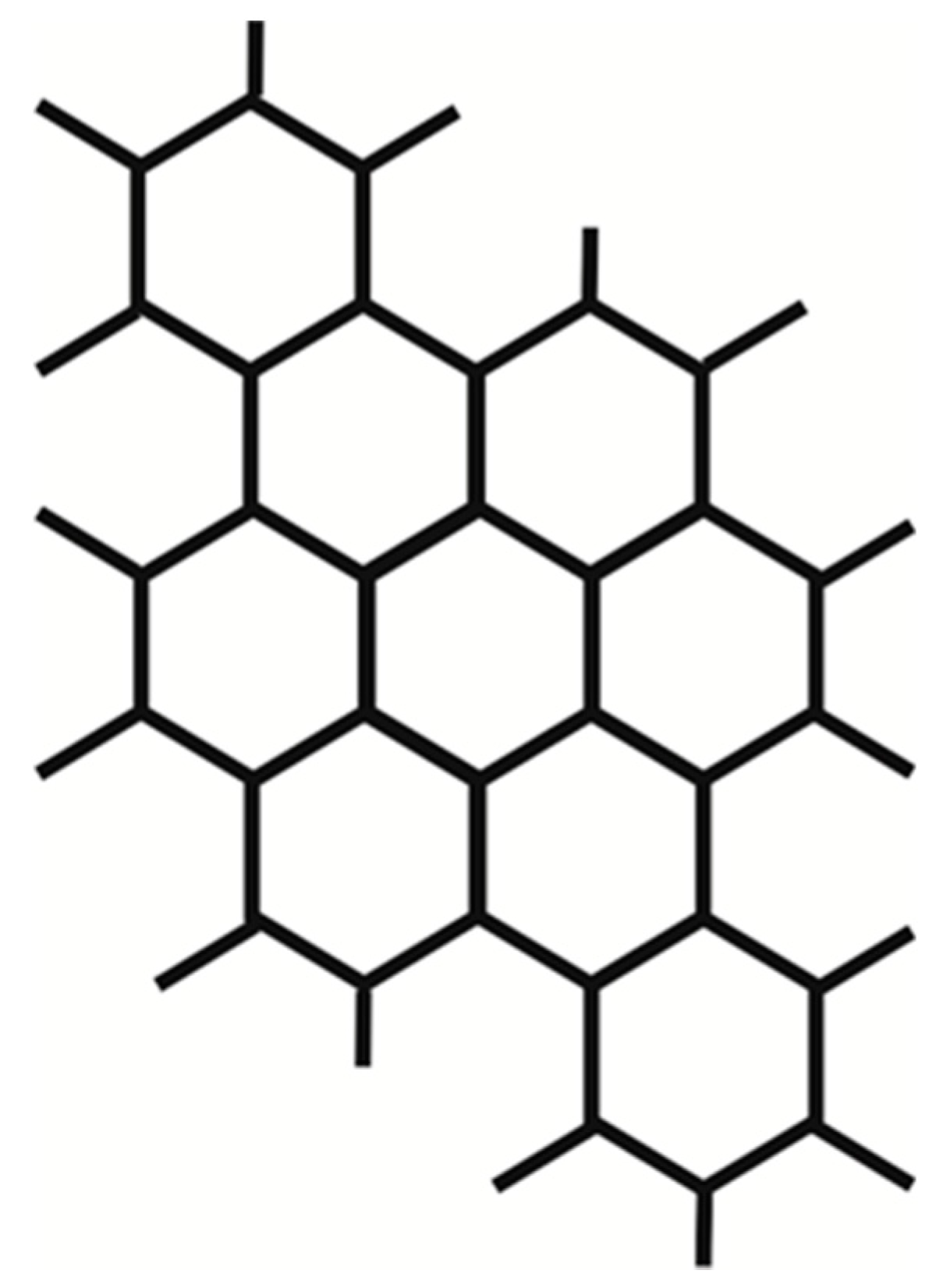
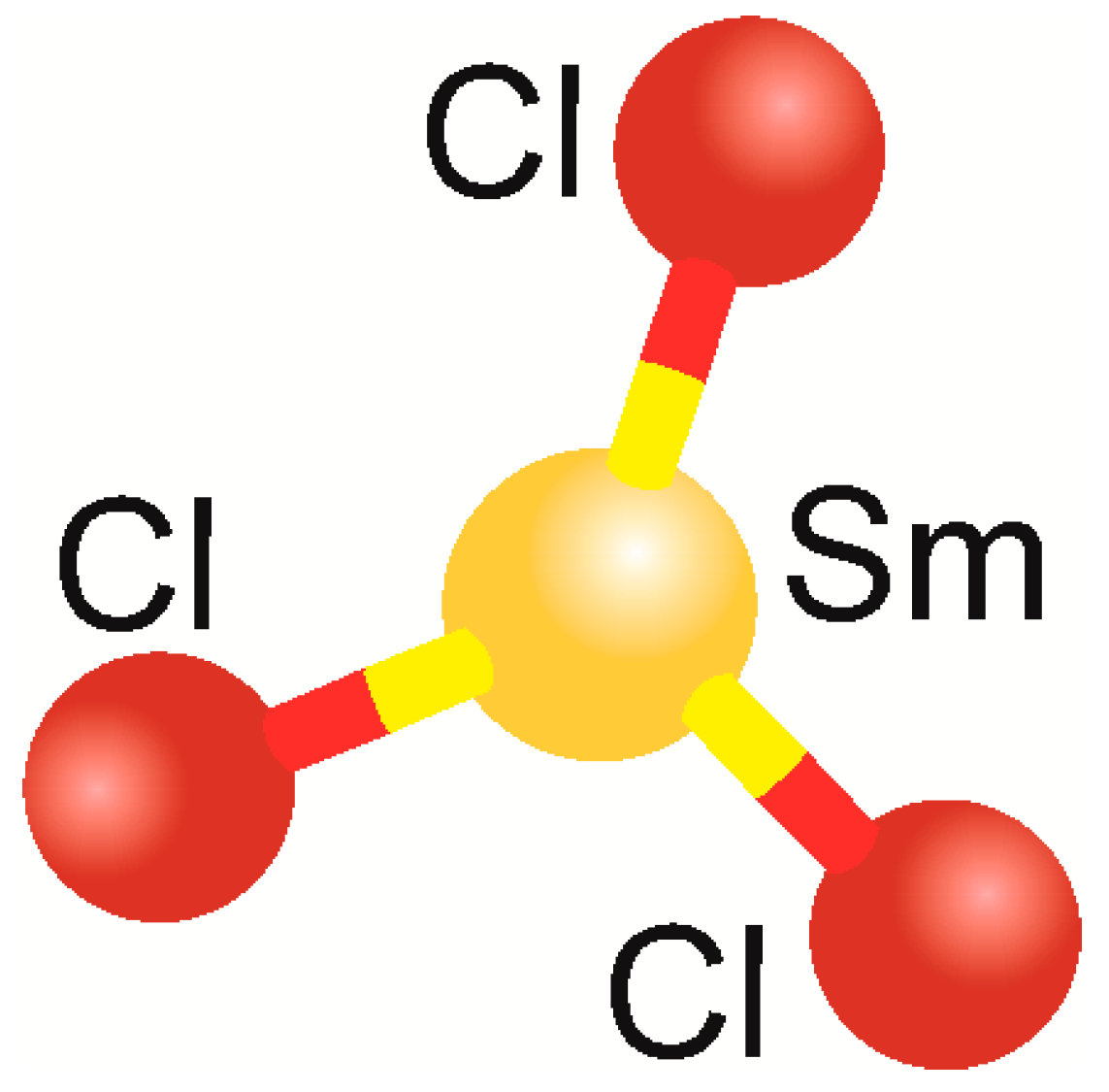
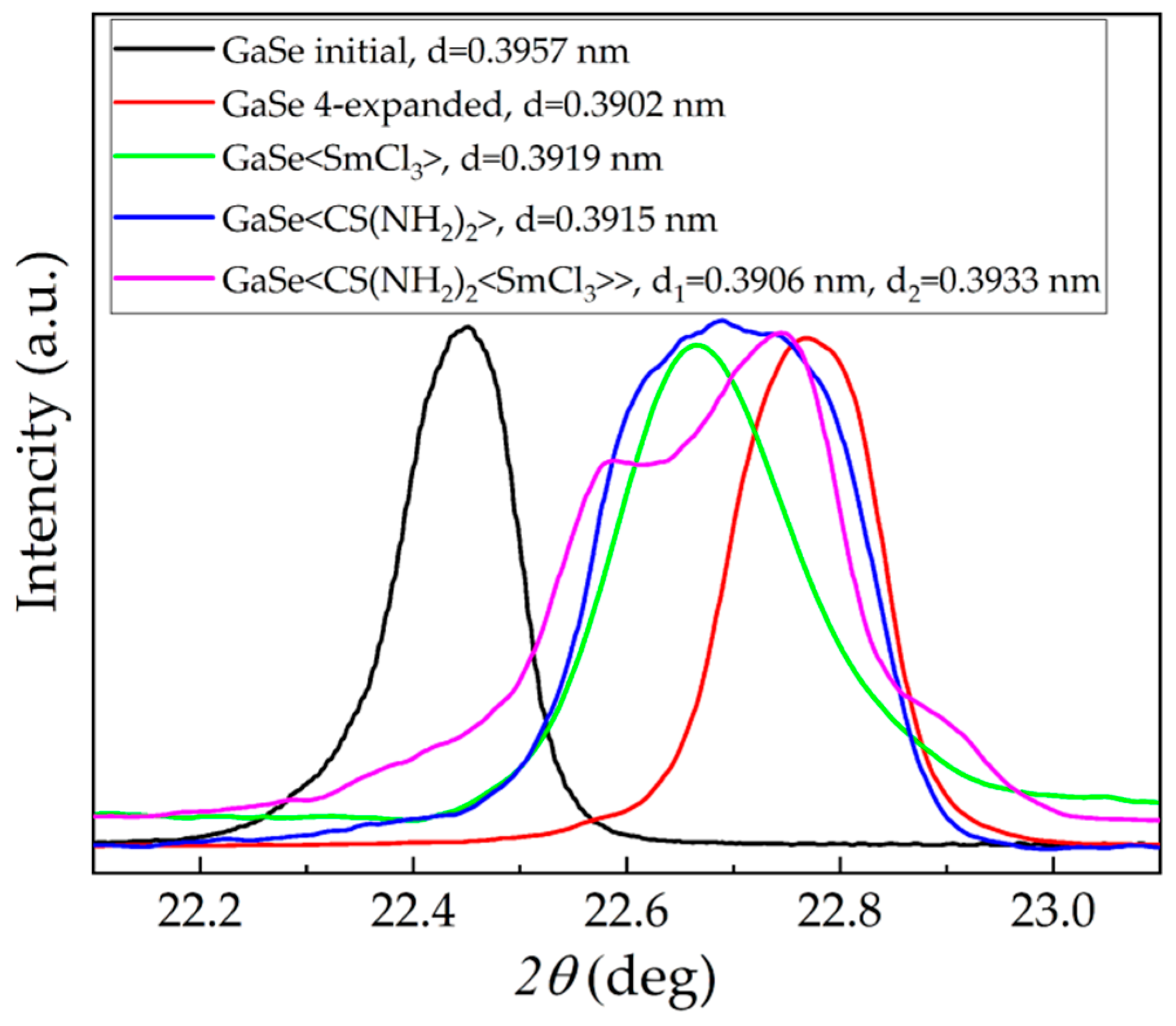
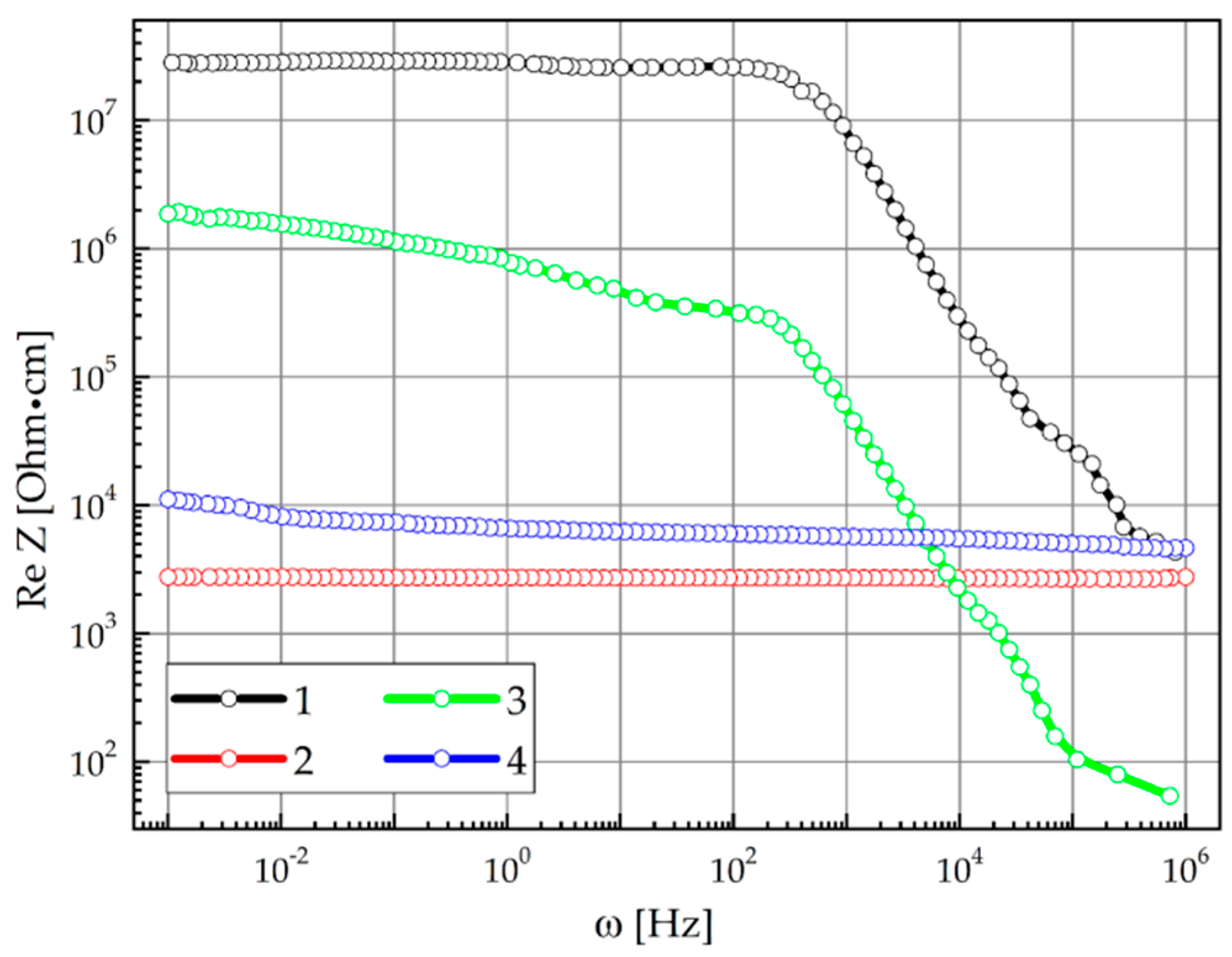
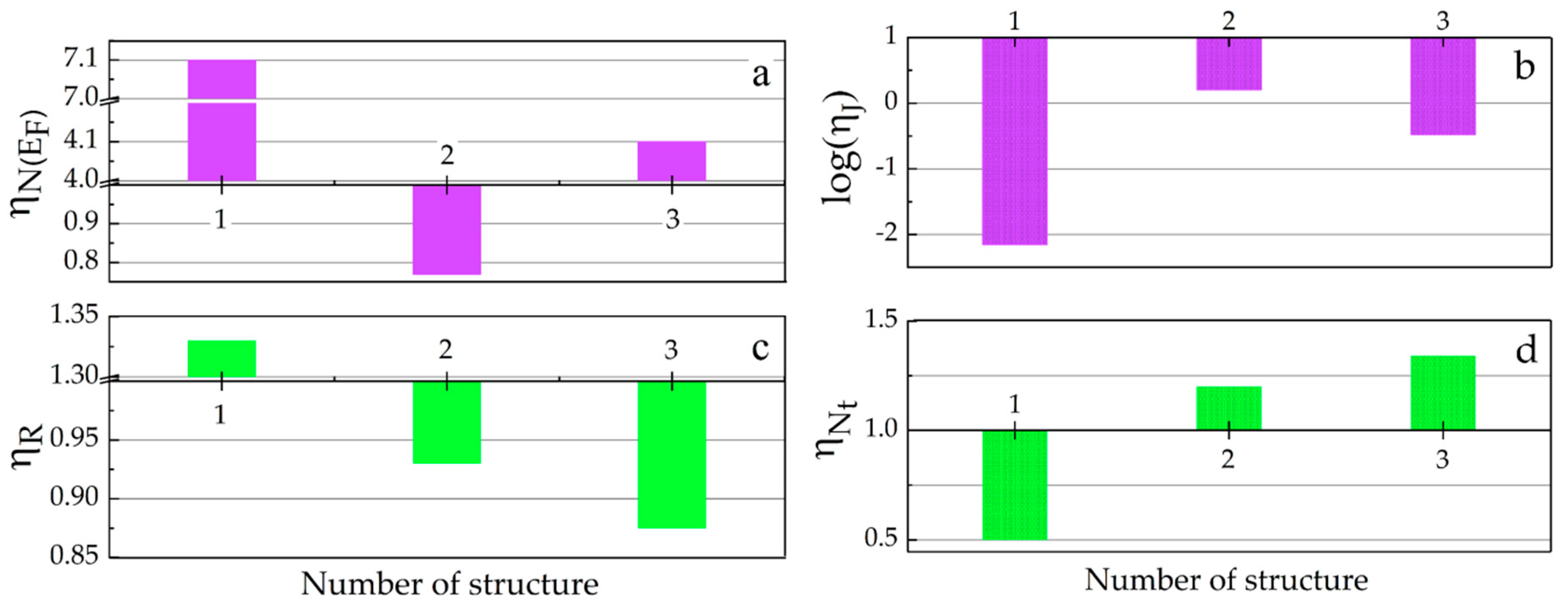
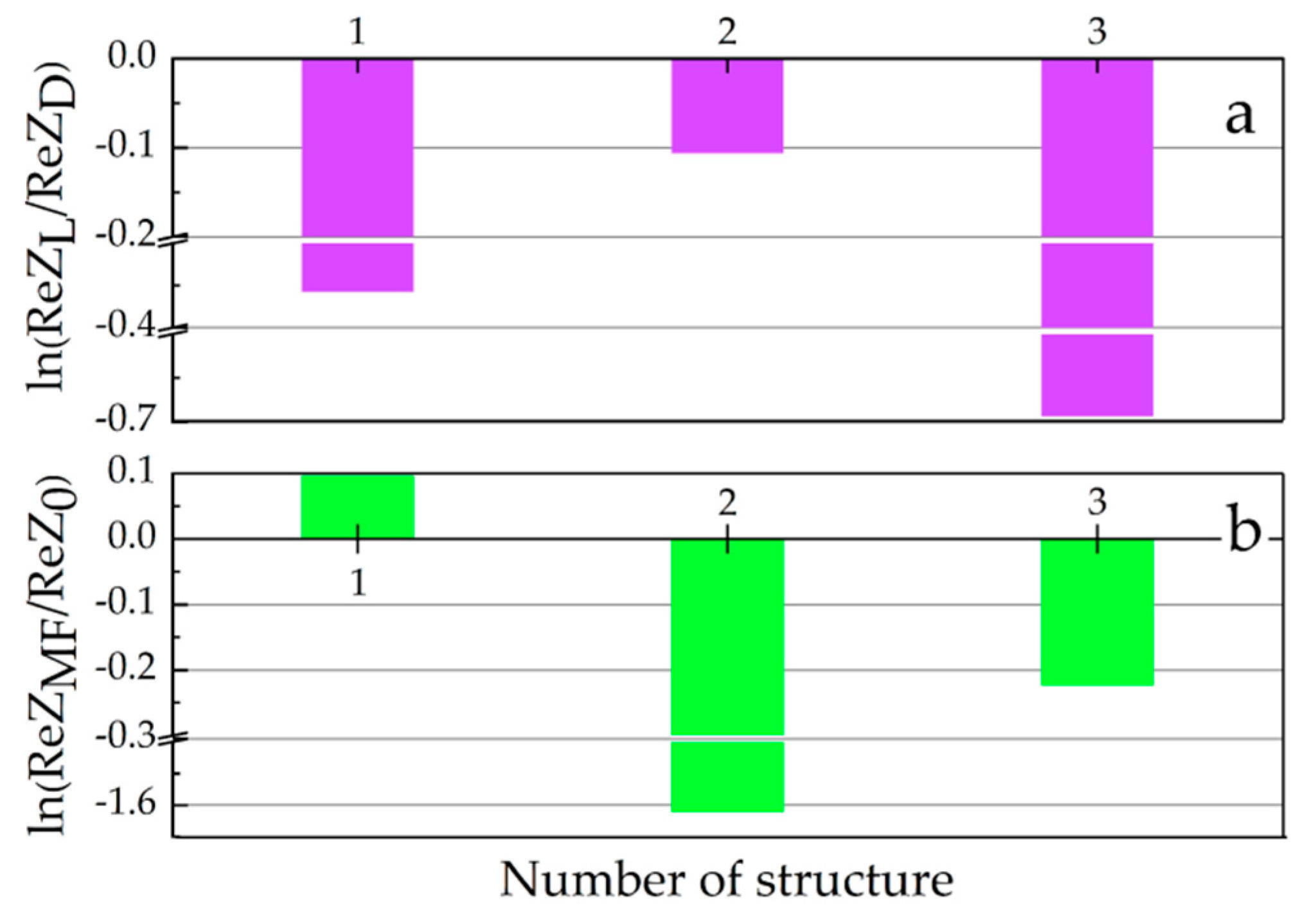
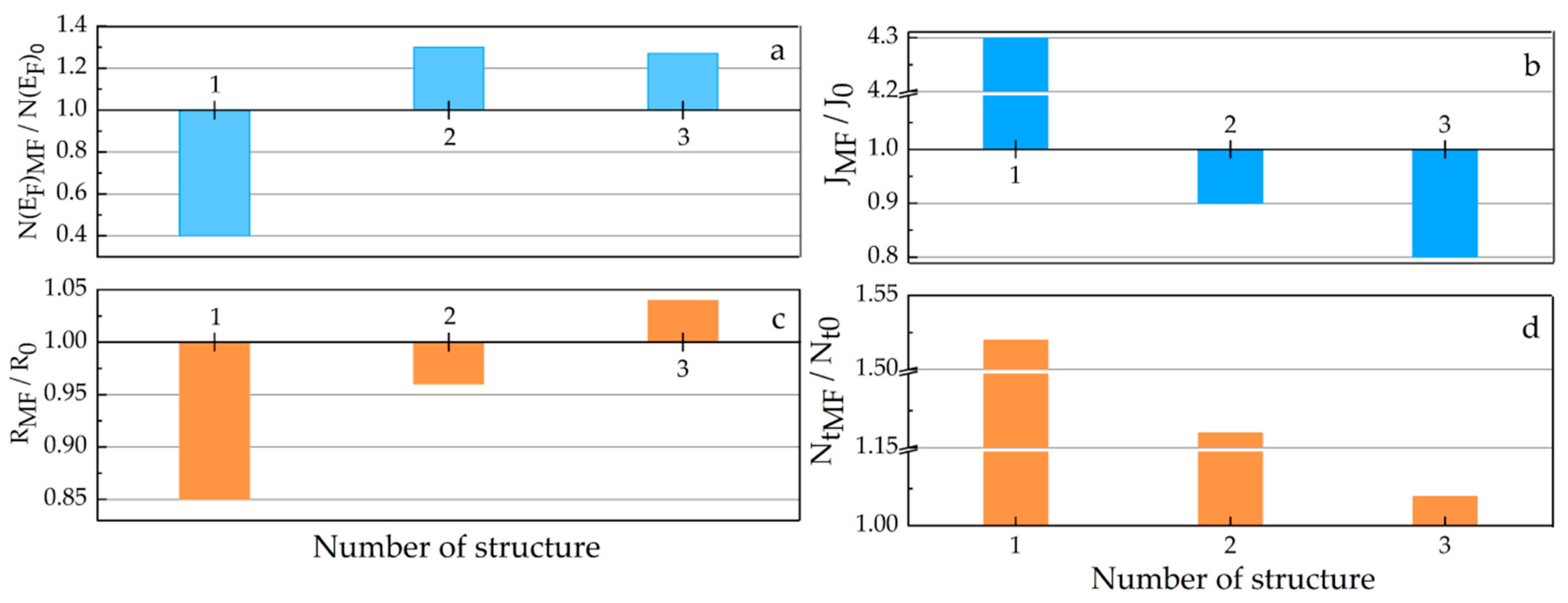
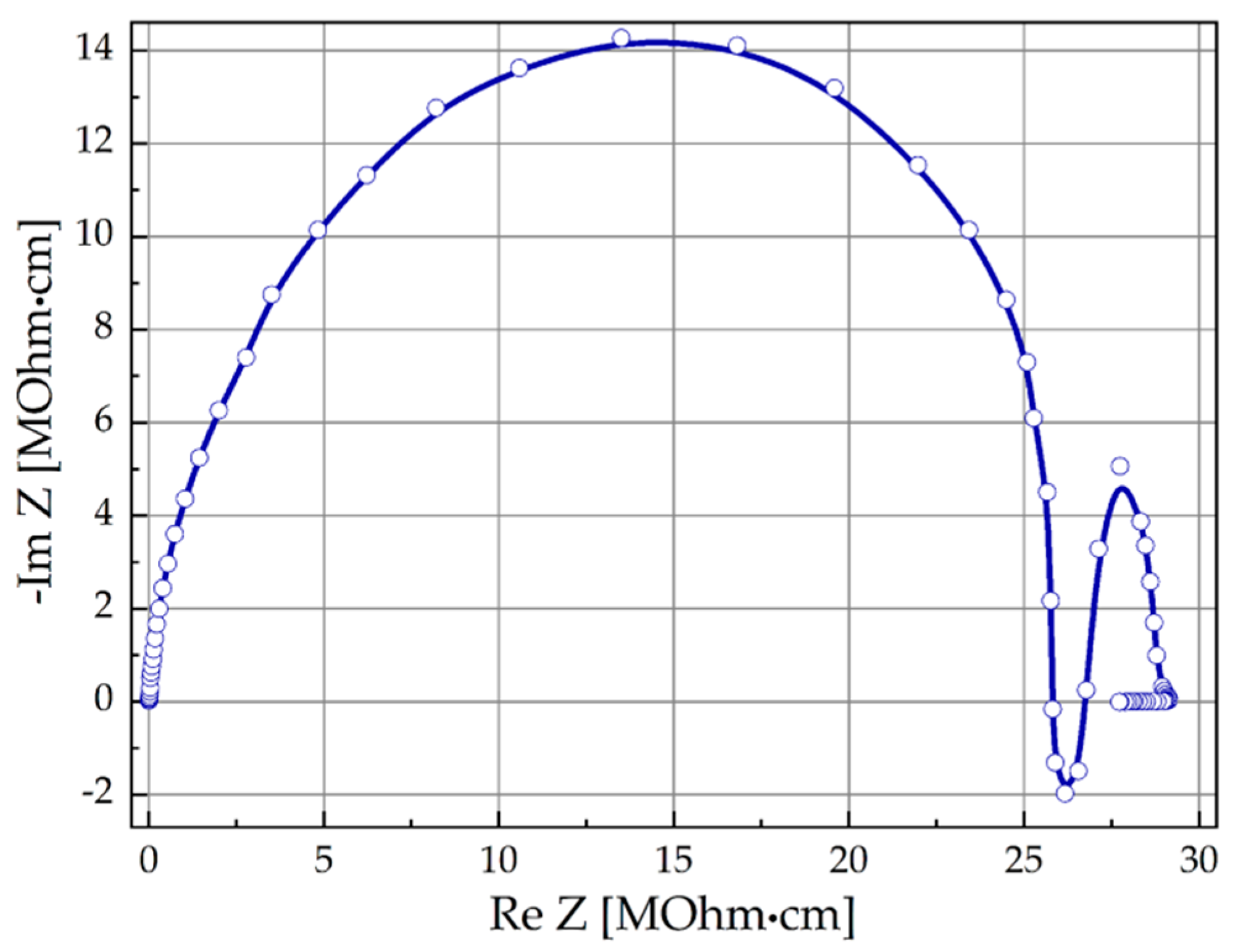
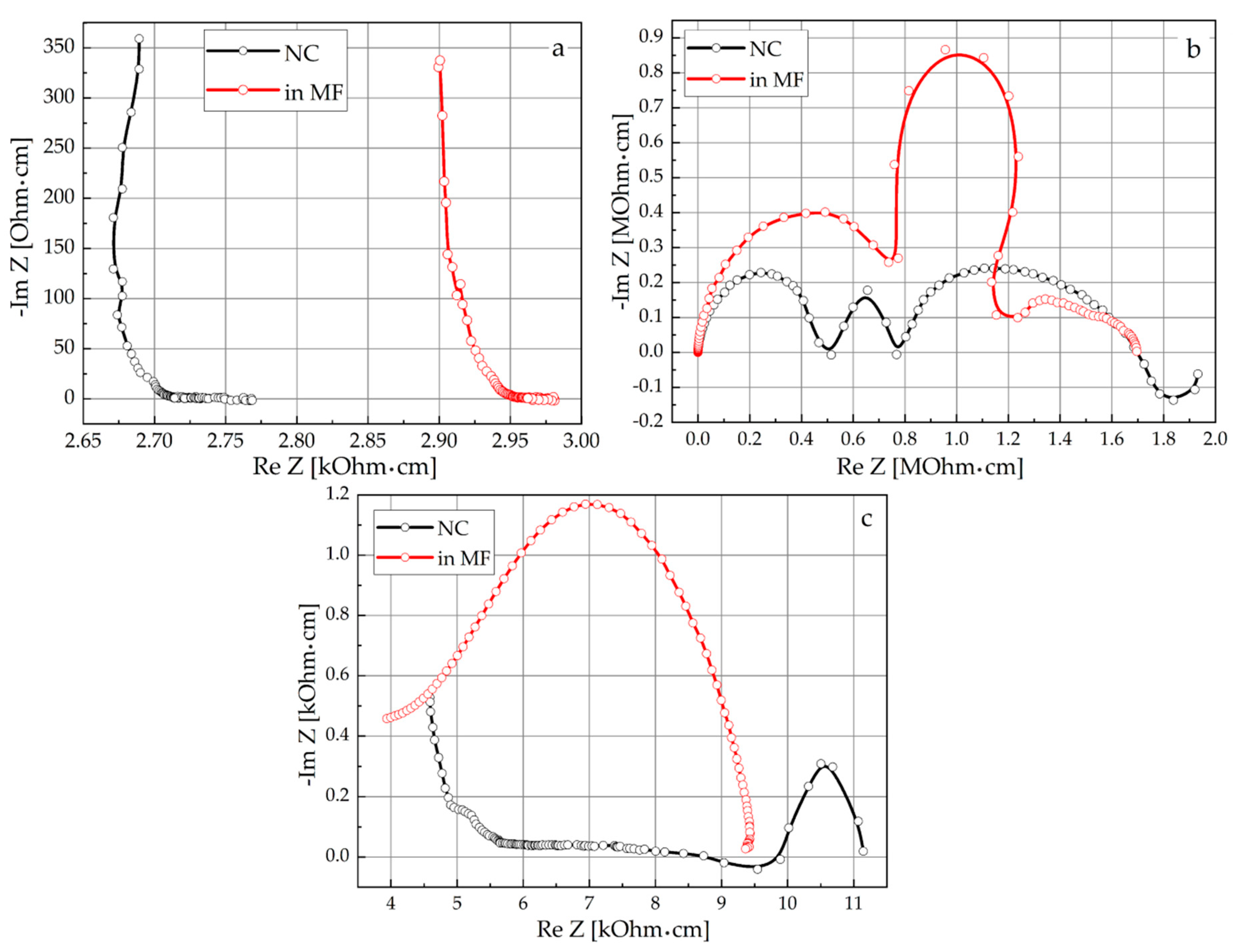
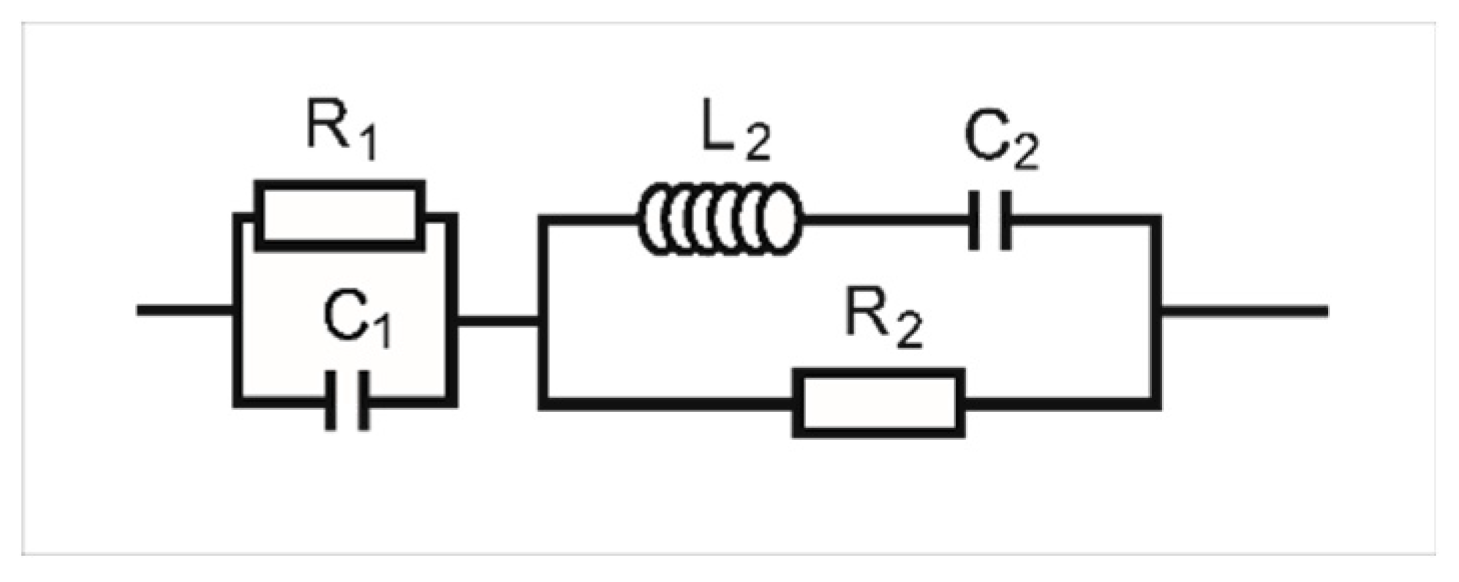
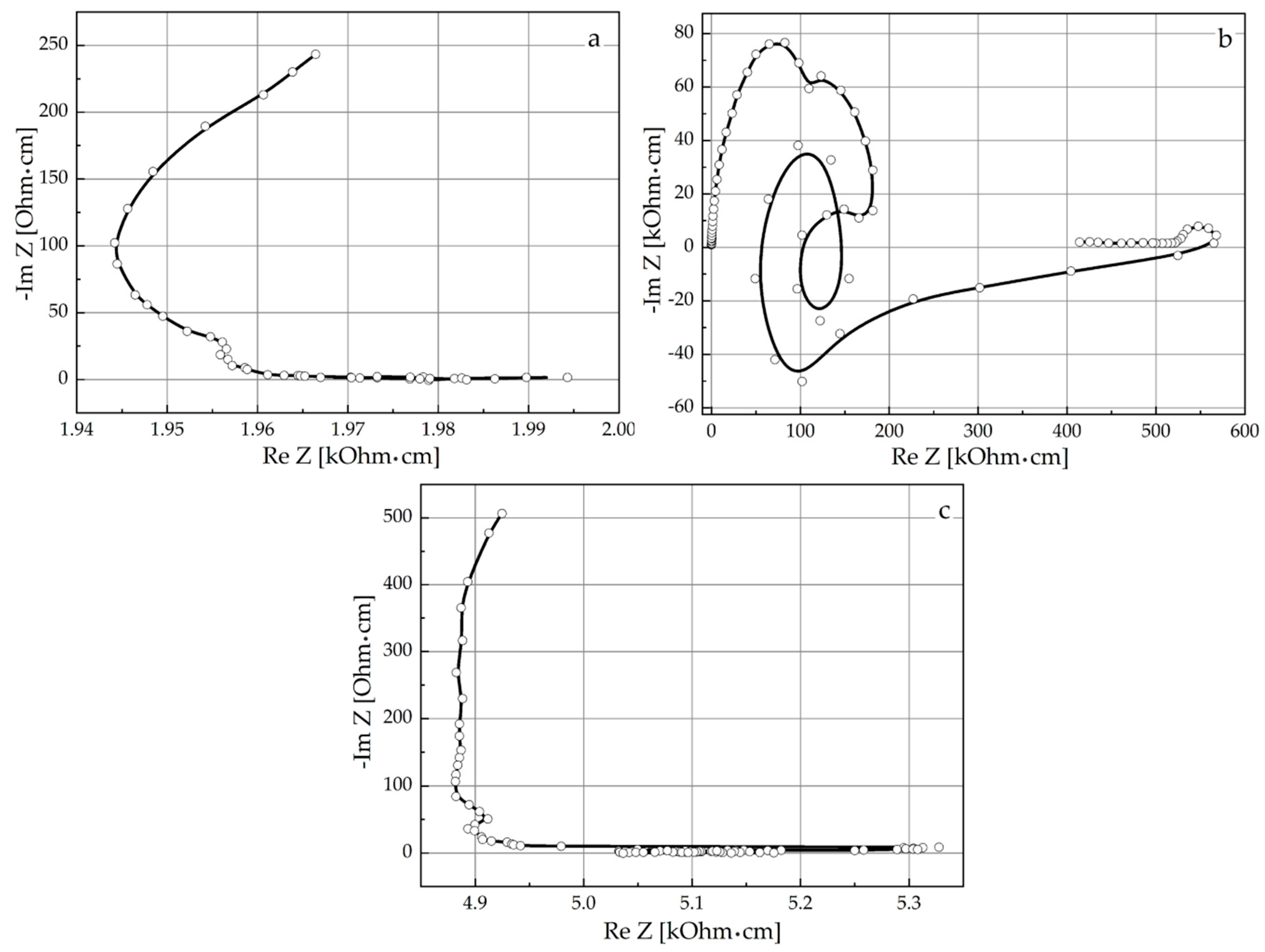
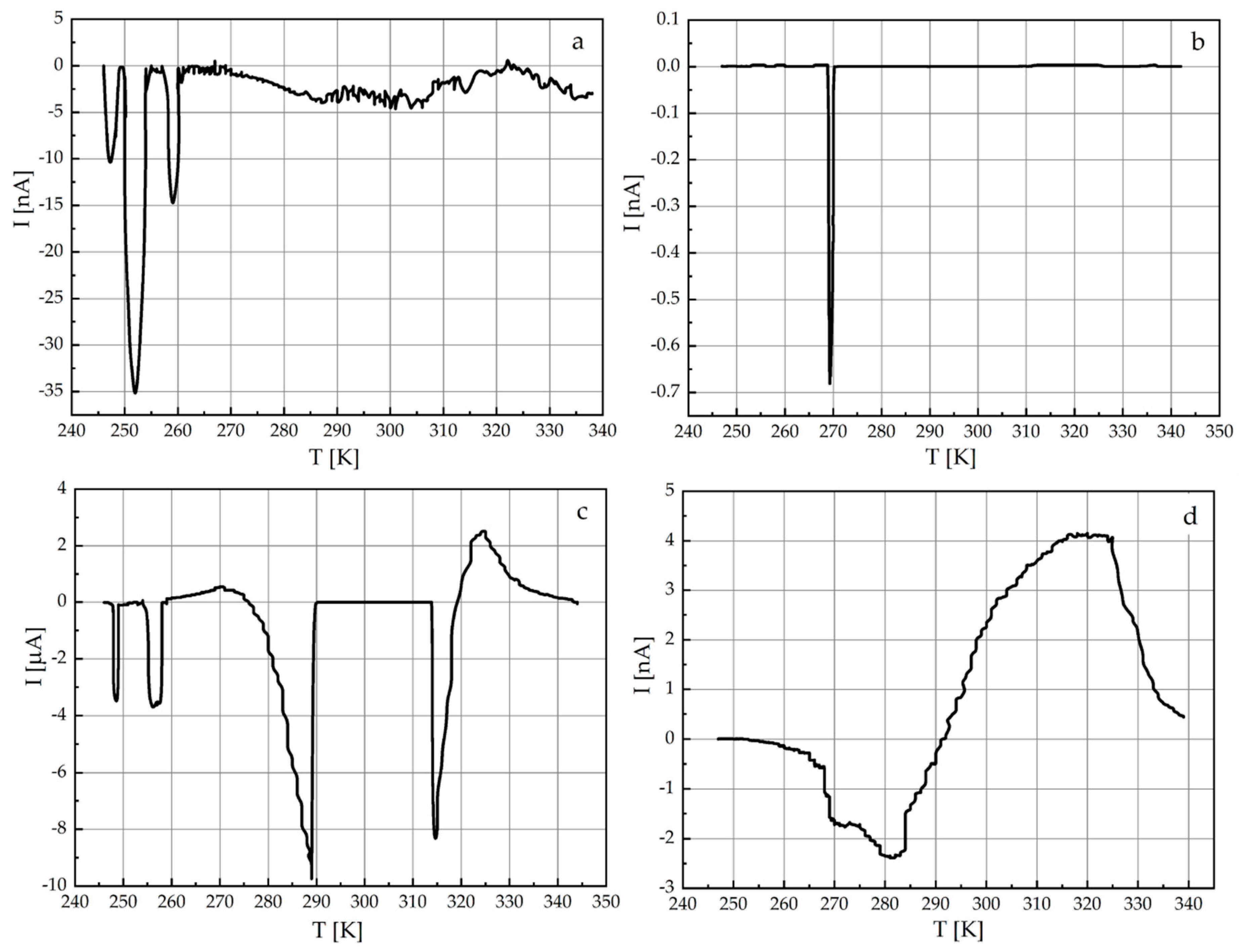
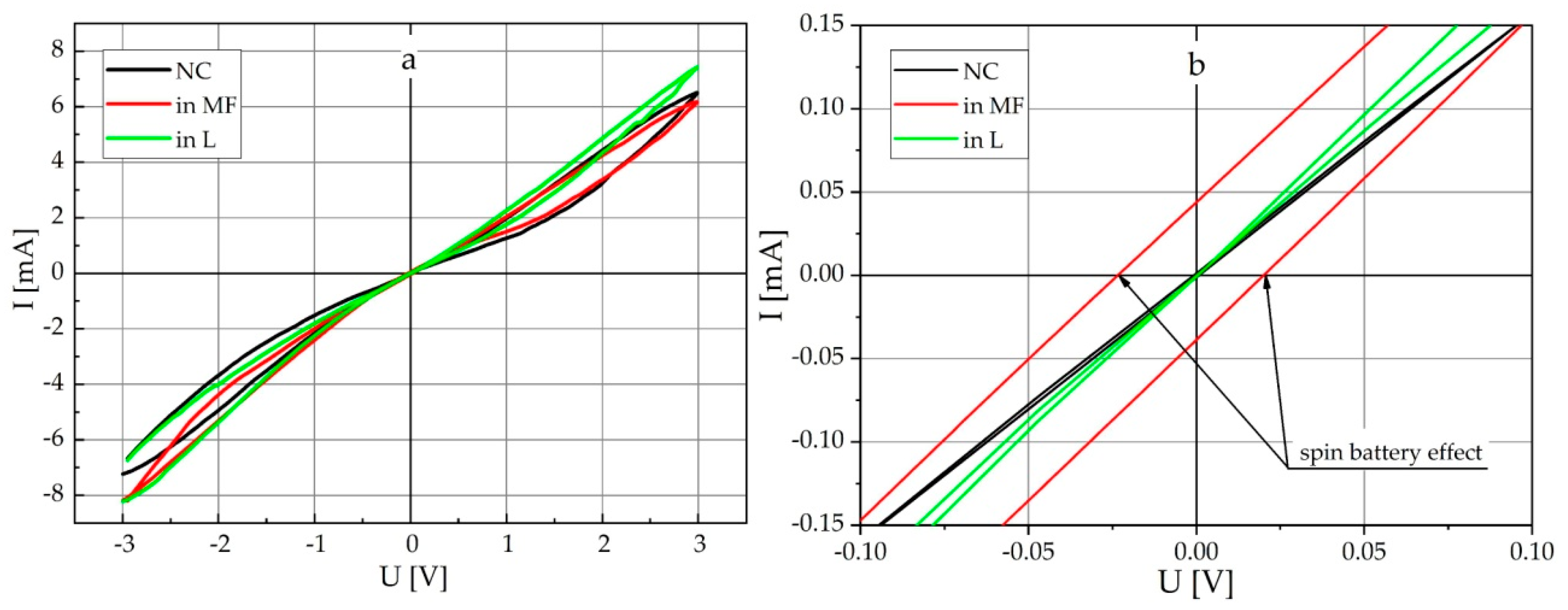
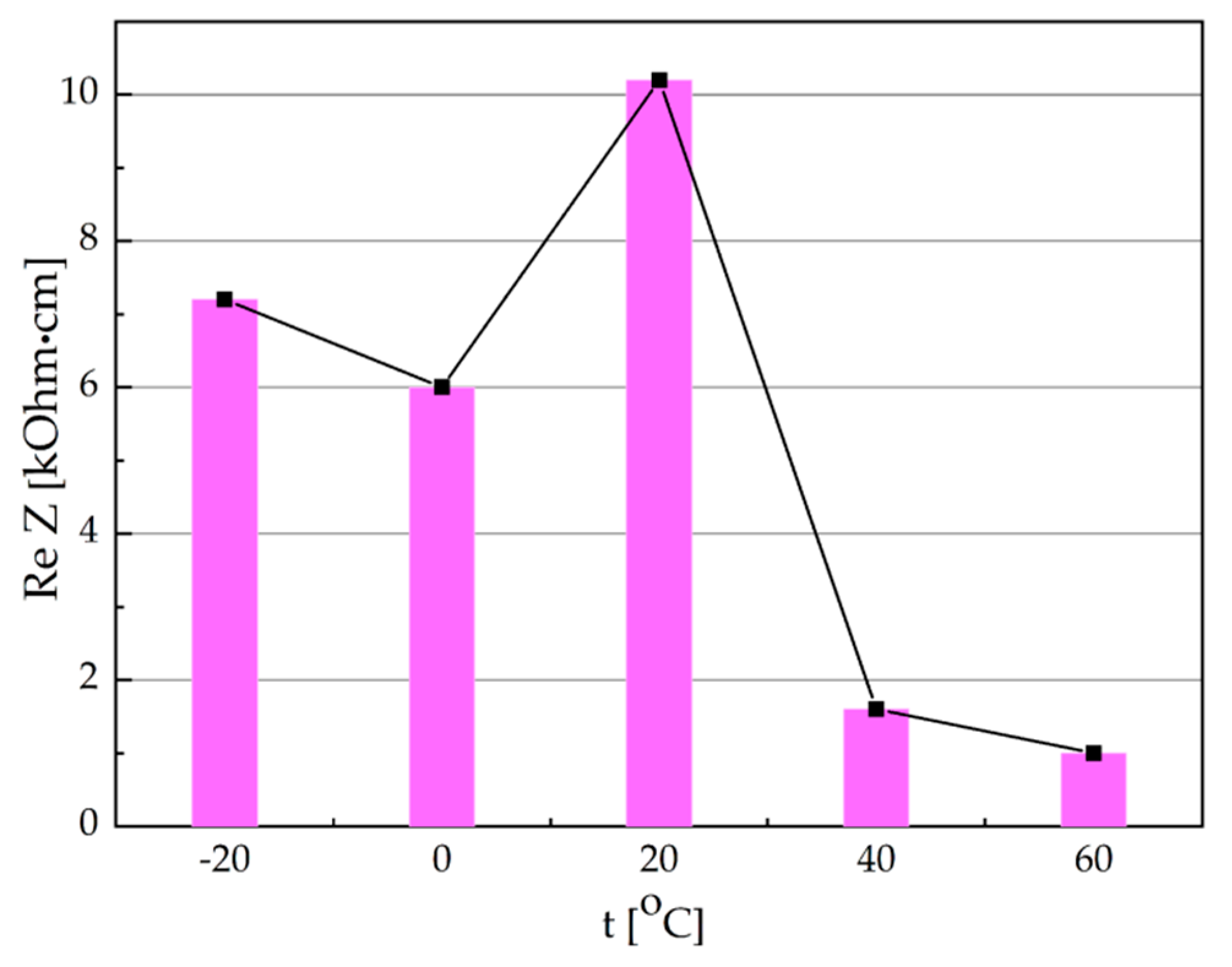
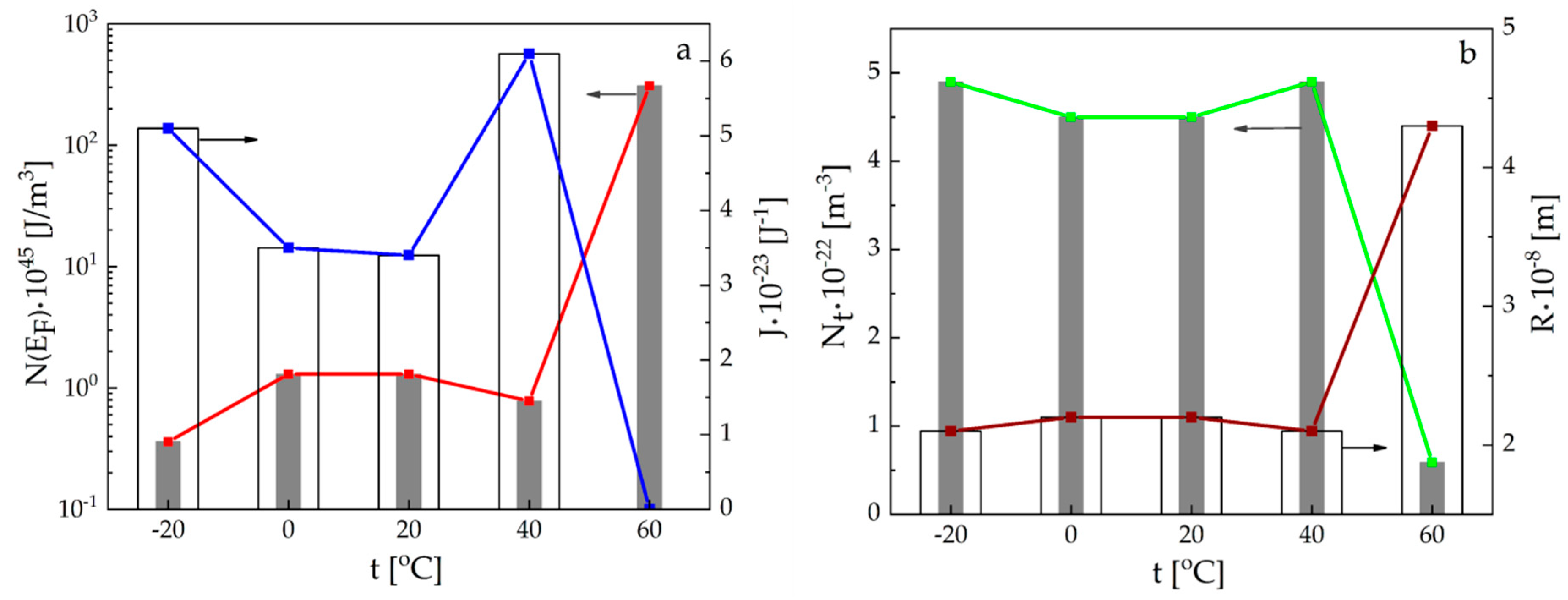
| Structures | Magnetoresistive Effect ln(ReZMF/ReZ0) | Photoresistive Effect ln(ReZL/ReZD) | Inductive Response | Energy Accumulation at Quantum Level | Spin Battery Effect |
| GaSe(CS(NH2)2) | 0.09531 | −0.35667 | − | − | − |
| GaSe(SmCl3) | −1.60944 | −0.10536 | + | − | − |
| GaSe(CS(NH2)2(SmCl3)) | −0.22314 | −0.69315 | − | + | + |
© 2020 by the authors. Licensee MDPI, Basel, Switzerland. This article is an open access article distributed under the terms and conditions of the Creative Commons Attribution (CC BY) license (http://creativecommons.org/licenses/by/4.0/).
Share and Cite
Chabecki, P.; Całus, D.; Ivashchyshyn, F.; Pidluzhna, A.; Hryhorchak, O.; Bordun, I.; Makarchuk, O.; Kityk, A.V. Functional Energy Accumulation, Photo- and Magnetosensitive Hybridity in the GaSe-Based Hierarchical Structures. Energies 2020, 13, 4321. https://doi.org/10.3390/en13174321
Chabecki P, Całus D, Ivashchyshyn F, Pidluzhna A, Hryhorchak O, Bordun I, Makarchuk O, Kityk AV. Functional Energy Accumulation, Photo- and Magnetosensitive Hybridity in the GaSe-Based Hierarchical Structures. Energies. 2020; 13(17):4321. https://doi.org/10.3390/en13174321
Chicago/Turabian StyleChabecki, Piotr, Dariusz Całus, Fedir Ivashchyshyn, Anna Pidluzhna, Orest Hryhorchak, Ihor Bordun, Oleksandr Makarchuk, and Andriy V. Kityk. 2020. "Functional Energy Accumulation, Photo- and Magnetosensitive Hybridity in the GaSe-Based Hierarchical Structures" Energies 13, no. 17: 4321. https://doi.org/10.3390/en13174321
APA StyleChabecki, P., Całus, D., Ivashchyshyn, F., Pidluzhna, A., Hryhorchak, O., Bordun, I., Makarchuk, O., & Kityk, A. V. (2020). Functional Energy Accumulation, Photo- and Magnetosensitive Hybridity in the GaSe-Based Hierarchical Structures. Energies, 13(17), 4321. https://doi.org/10.3390/en13174321








